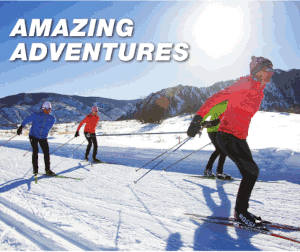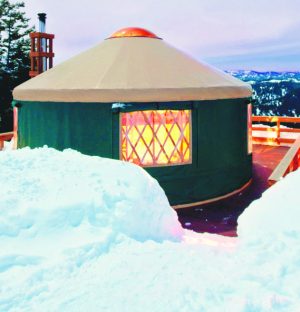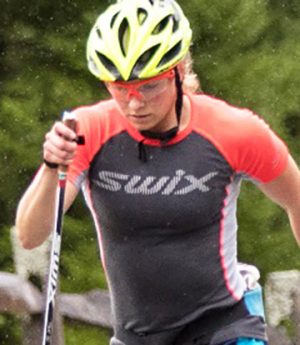August 27, 2007 (Denali National Park, Alaska) – Aaron Saari, the first fulltime physical therapist for the U.S. cross country and nordic combined ski teams, gave himself a memorable gift for his 32nd birthday: he climbed to the summit of Denali, the tallest peak in North America. He thanked World Championships medalist Bill Demong (Vermontville, NY) for a key boost on the final stretch.
“I summited Denali on my birthday [May 16], and that was definitely cool. We didn’t plan it that way,” said Saari, who climbed with a friend, Scott Wazny of Portland, OR, a veteran who had reached the top of Mount Everest in the Himalayas. “We made good time and it just worked out. I’d felt, ‘There’s no way we can get to the summit in this amount of time.’
“But it’s almost more like the mountain decides – or allows you to make it to the top. You’re there for the experience, you give it your best shot…but you also have to be able to say, ‘No, it’s too dangerous now and we’re going back.’ But a lot of people don’t want to give up that chance…and that’s when they can get into trouble. The day after we summited, two people died on that [West Buttress] route.”
Denali , a.k.a. Mount McKinley, has an elevation of 20,320 feet. Previously, Saari’s highest climb was Washington’s Mount Rainier (elev. 14,410 feet). In his second season with the U.S. Ski Team, Saari was on the staff of Oregon Health & Science University after working at Hood River Physical Therapy where the staff included Gillian Honeyman, U.S. Snowboarding’s PT. His ascent made Saari the second U.S. Ski Team member to conquer Denali: four-time Olympian Nina Kemppel made it to the top with her father in 1995.
Started climbing in college
Saari grew up in White Pine, MI, west of the Michigan Tech campus in Houghton, where the U.S. Cross Country Championships were held last January and the 2008 championships will be staged. An alpine skier as a youngster, he began cross country skiing at the University of Michigan; while there, he met some ice climbers and joined a trip into Canada.
“I loved it and, naturally, that led to wanting to climb bigger mountains, so I did more mountaineering.” After earning a bachelor’s degree in exercise science at Michigan, he took a master’s degree in physical therapy at Central Michigan. Eventually, he said, “I decided I might just as well go live near some big mountains, so I packed the car and moved west, and ended up in Portland. The Cascade Mountains are a perfect spot for mountaineering.”
Following a short notice email, Saari joined Wazny in Alaska on May 5, shortly after the 2007 FIS Nordic World Ski Championships in Sapporo, Japan. They flew to Denali’s base camp the next day, the only flight able to land that day due to sketchy weather. They began climbing on the seventh. “And we were standing on the summit on the 16th,” he said.
“It was a lot faster than we thought. More than anything, there weren’t a lot of technical challenges – certainly enough to claim your life if you make a mistake, but nothing overwhelming. It’s just a lot of work,” according to Saari, “because you don’t have sherpas like on Everest.”
“It can be so dangerous…”
Each of them lugged 120 pounds up the mountain, via backpack and sled. “It’s exhausting work. I think people run into trouble because they’re exhausted…and it can be so dangerous when the weather gets bad,” he said.
“There was one tricky part, from the camp at 11,000 feet to the 14,000-foot camp, but we were able to beat a storm. We were above it, and it dropped three feet of snow, keeping other climbers at 11,000 feet for another three or four days.”
Near the summit, they hit a freezing wind. “We rounded this corner and the wind was like a stone cold slap in the face. I couldn’t even talk to my buddy; I had to get right in his ear. They had to be 60 mph winds and it was about -30 [F.] without the wind chill.”
He was concerned about a possible fast-moving storm trapping them, but Wazny replied, “‘No, it’s clear. Keep your eyes open. We’re healthy and moving fast.’ About 50 percent of the climbers around us went back, but Scott was comfortable, so we kept going into the winds. I had borrowed apair of goggles from Bill Demong; an hour into it, I took off my sunglasses and put the goggles on.
“Eventually, the wind, which was cutting through everything, blew thegoggles off…but we reached the point where it was going to happen. When we reached the summit, it was calm, sunny and there were tiny clouds below us.”
The view over the Alaska Range was breathtaking. “You run out of adjectives,” Saari said. “There just aren’t the words when you’re standing on top and it all comes together. It can be life-changing.”
Top News Stories
US Nordic Physical Therapist Conquers Alaska’s Denali
release by USSALeave a Reply
You must be logged in to post a comment.





![National camp action [P]...](https://skitrax.com/wp-content/uploads/2019/08/Duluth-4-2019-08-08-at-10.46.51-AM-300x246.png)
![Matt Liebsch on the CXC Elite Team [P] CXC...](https://skitrax.com/wp-content/uploads/2019/08/Matt-Liebsch-CXC.2-525x700.4-300x267.jpg)
![Dan LaBlanc [P]...](https://skitrax.com/wp-content/uploads/2019/08/Dan-LaBlanc-img_1855.3.jpg)
